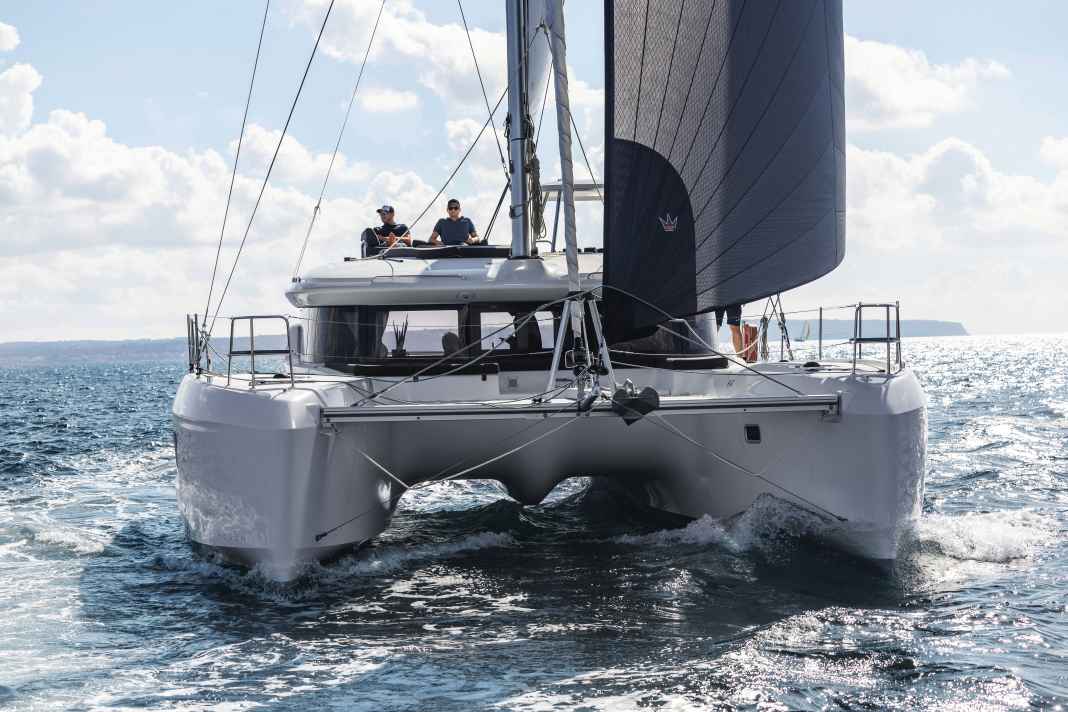





- More volume, more living space
- Extreme hulls on the Lagoon 43
- Huge berths fore and aft
- Great advantages for owners
- How the Lagoon 43 sails
- Operating the Lagoon 43
- Roof terrace for chilling out
- Expansion of the Lagoon 43
- Price of the Lagoon 43
- YACHT review Lagoon 43
- Technical data Lagoon 43
- Competition from the Lagoon 43
The trend for monohulls has been around for a long time and is now ubiquitous. Following the general growth at the stern, the hulls are now also becoming increasingly voluminous in the foredeck, sometimes with almost bizarre shapes. The designers promise better sailing characteristics and more performance, especially for regatta boats. These arguments are often coupled with the welcome side effect that the wider hulls naturally also provide more living space below deck. A win-win development, therefore, for an extremely wide range of different yacht orientations.
More volume, more living space
In contrast, this trend has only begun to emerge in multihulls. Although the hulls of catamarans have also become increasingly voluminous over time, they are nowhere near as voluminous as the monohull designs of recent years. Now none other than the industry leader Lagoon is starting the reform with a new 13 metre boat. Together with the designers from VPLP, the catamaran builders from Bordeaux have now unveiled a new boat that features extraordinary innovations in many areas. The hull moulds in particular are causing quite a stir.
Extreme hulls on the Lagoon 43
For the new Lagoon 43, the designers have clearly gone to extremes. The bulky foredeck areas with their volume pulled far forward are visually striking. Added to this are the hard-set chines, which extend over the entire length of the hull. This is intended to keep the waterline slim and the wetted surface as small as possible despite the wide hulls. The shapes are almost reminiscent of the exotic scow designs of modern ocean racing yachts such as the Class 40.
Huge berths fore and aft
However, at the centre of the development is rather the intention to obtain more space for a new, perhaps revolutionary design below deck. Thanks to the new design, the space in the forward cabins of the new Lagoon 43 is just as large as in the aft cabins. The double berths are also the same size fore and aft.
This opens up the possibility of moving the owner's berth to the foredeck in a three-cabin layout, while the large wet room is installed completely aft. This is the big surprise at the market launch of the Lagoon 43 and at the same time a real novelty in the world of catamarans, at least in the small and medium length segments.
Great advantages for owners
The advantages are numerous: the owners sleep more quietly and with more privacy in the foredeck, especially if the boat is moored with the stern facing the quay or pier. In addition, sources of noise such as engines, generators or the crew working in the cockpit are further away. This can be an issue on long trips in particular. And the ventilation options are better at the front because larger hatches can be installed on deck. These are arguments that have long been used in conventional monohulls. The concept of the Lagoon 43 thus shows new parallels between monohull and twin-hull boats.
But the question is: How would the new, fuller hull shapes of the Lagoon 43 affect the sailing characteristics and behaviour in high waves? It is not for nothing that the hulls of particularly powerful catamarans are generally long and slim. With the new Lagoon, however, the development is going in exactly the opposite direction. The YACHT test takes place off Palma de Mallorca, on the occasion of the tests for the European Yacht of the Year award, for which the new boat from Bordeaux was nominated. However, it did not win the coveted prize.
How the Lagoon 43 sails
With only medium wind forces, the wave height in the bay unfortunately remains only moderately high, about half a metre. This is hardly enough to make any statements about the characteristics in rough seas. Despite its relatively high weight, the Lagoon 43 feels surprisingly light, reacts quickly and intensively to rudder movements and can also be steered quickly through the tacks. However, the turning angles remain large at 110 degrees.
In ten to twelve knots of wind, the Lagoon reaches a speed of just over five knots with an overlapping genoa and optional battened mainsail with squarehead. The Code Zero delivers more speed, more dynamics and, above all, more fun sailing from a wind angle of around 80 degrees. The additional sail with the corresponding equipment package is highly recommended as an option.
It is also noticeable that the hulls hardly draw any stern water. The backwash, which is typical of catamarans but is often disruptive, is almost completely absent on the Lagoon 43, and the current at the stern breaks off cleanly. This is probably also a consequence of the full hulls with little keel jump and low immersion depth. The eddies at the stern only reappear from a speed of around seven knots.
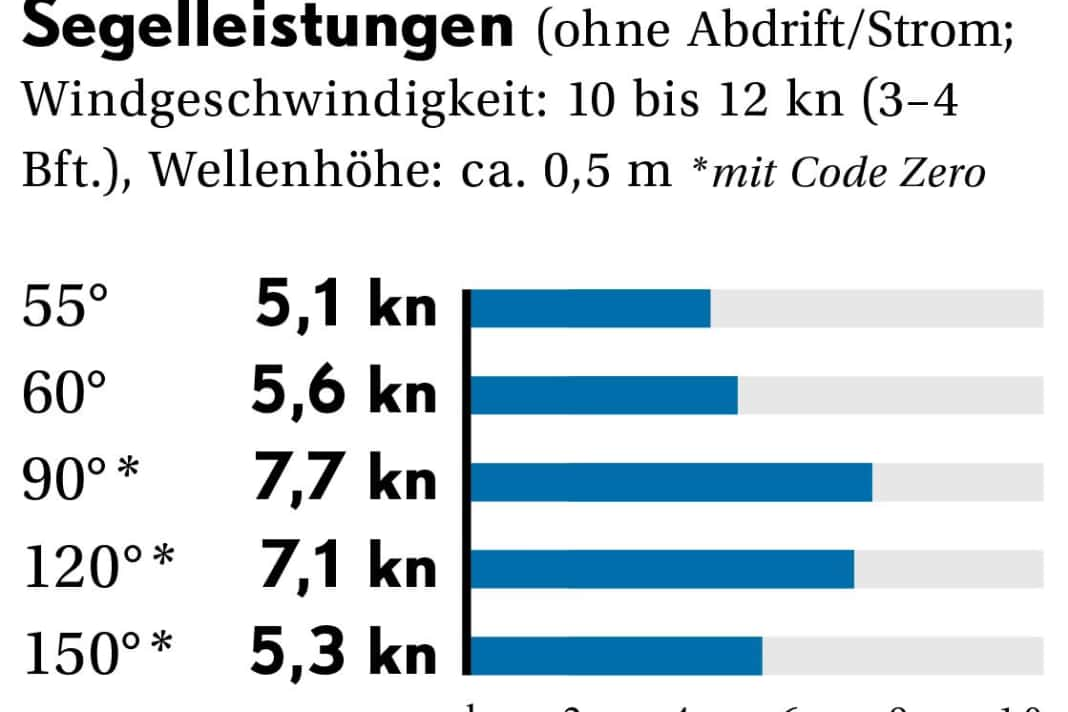



Operating the Lagoon 43
Halyards, sheets and winches can be operated effortlessly. The layout is very well thought out and can be operated single-handed even with an overlapping genoa. The steering position is very spacious, allowing two people to work at the same time without obstructing each other when manoeuvring. Handling is made easier by the good basic equipment with powerful stoppers, large winches from Harken and properly dimensioned blocks and rollers. For manoeuvring in the harbour, both sterns can be seen from the helm and the bow on the port side.
On the predecessor model, the Lagoon 42, the designers placed the rig conspicuously far aft, roughly in the centre of the overall length. The mast was higher, the mainsail slim and the self-tacking jib standard.
Lagoon has moved away from this with the new boat. On the Lagoon 43, the mast is once again positioned at the front on the roof of the deckhouse, supported by the forward cabin bulkhead. The mast support in the centre of the saloon, as on the 42, has disappeared again. However, as the J dimension is significantly shorter, the self-tacking jib is no longer available as an option. The genoa with side hull points on the coachroof is once again a good standard.
Roof terrace for chilling out
A new feature is the spacious lounge area on the flybridge. The previous model only had sun loungers as an option for the upper deck. Now, guests on board can enjoy a proper seating area at a lofty height with plenty of space and additional cushions as sun loungers. However, the flybridge can only be reached via the helm station. On the foredeck, there is at least a small staircase for quick access to the roof, for example to hoist the mainsail.
Doors in the bulwark
Lagoon has extended the aft bulwarks from the cockpit to the stern. To make it easier to get on board when the boat is moored at the side of the jetty, doors have now been integrated into the side of the boat - a clever and well thought-out detail. The doors are sturdily built and also have an ingenious locking mechanism as a child safety device.
Expansion of the Lagoon 43
The owner's version
The buyer has the usual choice of interior fittings. The owner's version is equipped with two cabins and two heads to port and a long, full-length owner's cabin to starboard with a large and usable desk in the centre, plenty of storage space and a very spacious bathroom. This is installed in the stern as a novelty. A toilet room is completely separate from this as a separate area.
The charter variant
In the charter version, both hulls are equipped identically, i.e. with a total of four cabins and four heads. This layout variant corresponds to the standard within the 42-foot touring catamaran class, and there are no significant deviations from it among the competition. As the cabins and berths in the bow and aft of the Lagoon 43 are the same size, the layout is particularly interesting for the charter market, especially as each living area has its own wet room with separate shower. This is also a unique selling point among the competition.
Full-length salon
The spatial merging of saloon and exterior cockpit into a large, continuous living and lounge area has been a central theme in catamarans for years and is generally accorded great importance. On the new Lagoon 43, the connection between inside and outside is also an important component. The multi-part sliding door can be opened very wide, up to a maximum of 2.50 metres. In addition, the two seating groups and tables in the saloon and cockpit can be combined and extended almost at will with inserts, from a small coffee table to a large table for up to twelve people.
Spacious pantry
The spacious galley is built in an L-shape towards the front and offers a beautiful view forwards and to the side through the large, almost continuous window strip of the cabin superstructure. There is no shortage of work surfaces in the galley and the storage compartments are not only easily accessible, but also arranged in such a way that even larger items such as pots and pans can be stowed away.
No sat nav position
Strangely enough, Lagoon has dispensed with proper navigation on the new boat. There is a small work surface in the extension of the galley. But you can't really sit there because there are storage spaces underneath. And the area is too low for working standing up. It's a shame, because this area would also make a good navigation area for the inside steering position. The view forwards and to the side is almost unrestricted and the position of the genoa can also be checked from there.
Further details
What is missing in the saloon are holding options in the form of handrails, recessed grips or edge mouldings on the furniture. Anyone who sails in rough conditions will look in vain for support here. In general, this topic is often neglected in catamarans. On the other hand, the Lagoon 43 scores with its excellent ventilation options. There are several large openings in all living areas for good cross ventilation.
Price of the Lagoon 43
The prices offered by the major market-leading shipyards in this segment are similar, not least of course because a significant proportion of new production goes to the international charter market, where price plays an even greater role than in the owner's market. Lagoon is no exception to this rule and the new 43 is also within reasonable limits, also in terms of the additional costs up to the ready-to-sail and comfort price as defined by YACHT.
This is not the only reason why Lagoon's new concept is well-rounded, well thought-out and very well tailored to the contemporary needs of cruising sailors.
- Base price ex shipyard 593.810 €
- Price ready to sail 618.640 €
- Comfort price 662.260 €
As of 12/2024, how the prices shown are defined, read here!
- Standard equipment included: engine, sails, sheets, railing, navigation lights, battery, compass, cushions, galley/cooker, bilge pump, toilet, fire extinguisher, electric cooler, waste-holding tank with suction system
- For an extra charge: Sail dress (lazy bags) € 1,620, anchor with chain
2,800 €, fender/mooring 990 €, clear-sail delivery incl. antifouling paint 19,420 € - Guarantee/against osmosis 2/5 years
Surcharge for comfort equipment
- Line adjustment hole points n. raised.
- Traveller with line guide n. raised.
- Electric windlass incl.
- Tube kicker n. raised.
- Backstay tensioner n. raised.
- Jumping cleats incl.
- Sprayhood n. raised.
- Teak in the cockpit 11.300 €
- VHF radio E-package
- Log and echo sounder E-package
- Wind measuring system E-package
- Autopilot E-package
- E-package (Raymarine) 14.650 €
- Charger incl.
- Shore connection with RCD incl.
- 230-volt socket outlet (one) incl.
- 12-volt socket in the sat nav incl.
- Heating 17.670 €
- Pressurised water system incl.
- Hot water boiler incl.
- Shower WC room incl.
- Cockpit shower incl.
- Comfort price 662.260 €
- Also included in the price: Headsail furling system, telescopic swim ladder, table in the cockpit (GRP), storage space for life raft, steering wheel with leather cover.
YACHT review Lagoon 43
The Lagoon 43 is a voluminous cruising catamaran with a high level of living comfort. The extremely voluminous hull forms create new possibilities for the layout of space below deck. With the new model, Lagoon will once again be able to top the high standards in its class.
Design and concept
lots of volume, lots of space
comfortable flybridge lounge
Competitive price
no proper navigation
Sailing performance and trim
lively sailing characteristics
clear handling
large turning angles
little feel on the rudder
Living and finishing quality
Owner's cabin in the foredeck
Bright and cosy interior
all bunks the same size
Lack of holding options
Equipment and technology
Rig is in front again
overlapping genoa standard
impeccable ventilation
side doors in the cockpit
Technical data Lagoon 43

- CE design category A
- Hull length 12,82 m
- Total length 13,85 m
- Waterline length 12,68 m
- Width 7,69 m
- Draught 1,31 m
- Mast height above WL 19,94 m
- Theor. torso speed 8.6 kn
- Weight 13,3 t
- Mainsail (hours) 60,0 m²
- Furling genoa 37,0 m²
- Code Zero (opt.) 71,0 m²
- Machine (Yanmar) 2 x 57 hp
- Fuel tanks (2) 570 l
- Fresh water tank 300 l
- Holding tanks (3/4) 80 litres each
- Batteries 3 x 95 AH + 2 x 50 AH
Hull and deck construction
GRP sandwich constructions with balsa wood core and polyester resin. The laminates are constructed using vacuum resin infusion. The structures are reinforced with carbon fibre components in areas subject to higher loads. In some cases, the shipyard uses flax fibres instead of glass fibres.
Motorisation
- Two Yanmar engines (4JH57) with 57 hp are fitted as standard, with Saildrive propulsion and three-blade fixed pitch propeller.
Rig and sail
- The aluminium mast comes from the manufacturer VMG Soromap in France.
- A set of Dacron sails (main and genoa) from Elvström is included ex shipyard.
Batteries
- Standard: three service batteries (AGM 95 AH) and two starter batteries (AGM 50 AH).
- Lithium batteries for an extra charge (6,000 euros).
Winches
- Two winches in the cockpit (Harken 46.2 STA).
- Optional electric winches and two additional winches for gennaker and code zero.
Shipyard
- Lagoon Catamarans, 33072 Bordeaux (France), www.catamarans-lagoon.com
Distribution
Competition from the Lagoon 43
Capable competitor boats there are a few. Four sample boats with their own flavour:
Astréa 42
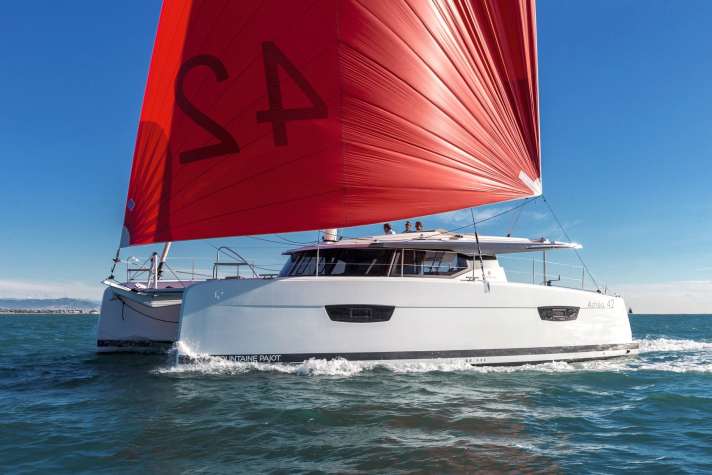
Voluminous cruising boat from Fountaine Pajot. The steering position is raised at the side, and there is also a spacious front cockpit. Interior fittings with three or four cabins, each with its own bathroom.
YACHT test Astréa 42....
Bali 4.2
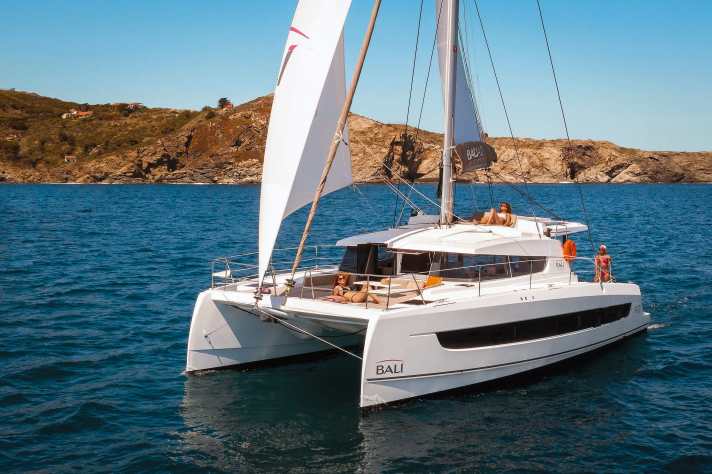
High-sided and very spacious cruising catamaran with flybridge lounge. The special feature is the continuous platform between the hulls with a huge front cockpit.
Test Bali Catspace 40...
Presentation Bali 4.4...
Leopard 42
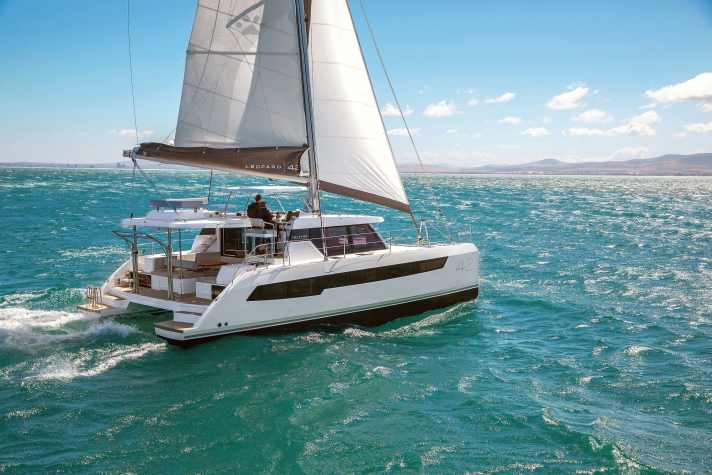
Built in South Africa, the cruising cat is designed to stand up to the strong competition from France. Despite its relatively high weight, the sailing characteristics are very good. The interior of the boat is beautifully finished.
YACHT test Leopard 42...
Vaan R4
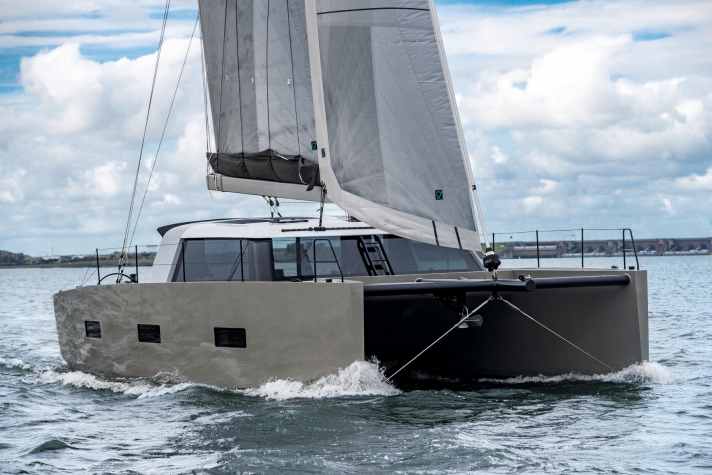
The sporty aluminium alternative comes from Holland. The cat is robustly built and shows its strengths under sail. Several extension variants are available. But expensive in comparison.
YACHT test Vaan R4...

